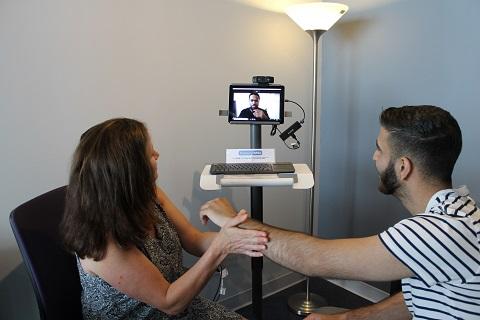Person-centered care allows individuals to play a greater role in determining the activities of their own lives. A crucial aspect of this is health care. A person-centered approach to supporting people with I/DD includes addressing health issues in ways that minimize negative impact on their daily routine while still meeting the needs of the person. It enables a higher quality of life. The individual can spend their days doing what makes them happy rather than spending more time than needed at doctors’ appointments, the emergency room and hospitals.

A demonstration of StationMD’s telehealth solution
Due to limited access to care, regulatory pressures and complex medical needs, people with I/DD tend to use the ER far more often than others in the population.
Telehealth can be an important tool in making person-centered care a possibility by providing individuals and their caregivers access to quality care from the home setting.
Scenario: Betty is eating lunch at her day program when she falls out of her chair. Though she is shaken, and complains of soreness in her wrist, she appears generally fine and wants to finish lunch and continue her day as planned. In fact, she is very excited for the planned music recital later that day, where she plays the recorder.
Typical Approach: Staff at Betty’s day program feel confident that she is okay but are worried about liability and regulatory concerns. With the pressure to send, they call 9-1-1 or bring her to the local Emergency Department on their own. They must all wait in the ER for several hours before being seen, at which point the doctor orders an X-ray of Betty’s wrist and a CT scan of her head “to be safe.” Betty spends the rest of the afternoon in the ER, stressed and out of her routine. The scan and X-ray come back normal, and she is told to ice her wrist.
Person-Centered Approach with Telehealth: Staff at Betty’s day program initiate a telehealth visit with a doctor, one who has access to Betty’s medical records and is board certified in emergency medicine. The doctor guides them in assessing Betty’s overall condition and wrist. Based on the evaluation, the doctor deems there is nothing seriously wrong and advises the staff to ice her wrist. Betty spends the rest of the afternoon enjoying her part in the music recital. It is a big success and gets huge applause from staff and family.
The use of telehealth can aide in keeping an individual in their routine, which is crucial to a person- centered care approach. As providers, it is our duty to ensure the ones we care for and love get to live their lives the way they want to; as we know, no two individuals are alike.
